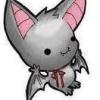Males fly, as suggested, because it's good for dispersing genes. Males of some night-flying species may appear at lights.
The spots on the queen's mesosoma are not wing vestiges. In fact, they're on the propodeum which is, anatomically, an abdominal segment - No wings there.
I would also note, those are pigment spots, not striations, which are defined as fine, parallel ridges of the exoskeleton (well, except when they are divergent fine ridges, as on Tergite I of Aphaenogaster mariae).
Fascinating. I found a clearer photograph, sans pigment spots.



















